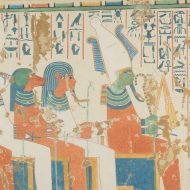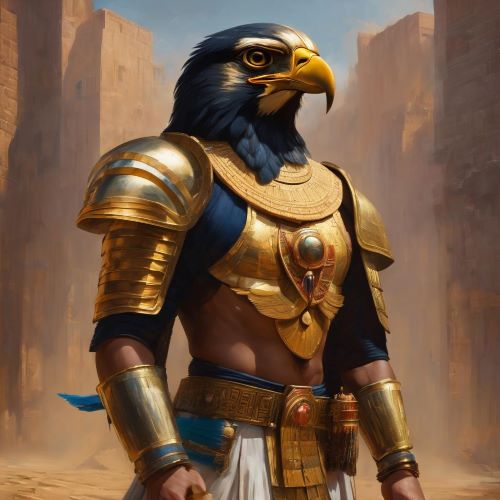Osiris : God of the Underworld
Listen
Osiris
Introduction
Osiris was one of the most important gods of the Egyptian pantheon and was believed to be originally a pharaoh from Syria. The myth of Osiris and the gods associated with it became part of the core belief system of Egypt. Osiris became so popular he absorbed the function of earlier gods such as Andjeti and Khentiamenti, two gods of fertility and agriculture worshipped at Abydos.
He is associated with the djed symbol and is often depicted with black or green skin symbolizing the fertile mud of the Nile and regeneration. He is also frequently shown as a mummy or in partially mummified form in his role as Judge of the Dead.
Physical Traits
He is depicted in his most developed form as a handsome god with the Atef crown, which consists of two curling ostrich feathers at the top. He also carries a crook and a flail. The symbolism of the crook is uncertain, though it is believed to represent a shepherd god. He was often depicted as a pharaoh with a green or black complexion. He was worn as a symbol of fertility in mummiform.
Family
He was the first-born of the god Geb and the Nut the sky god, who was murdered by his brother Seth. He was then brought back to life by his wife, Isis. Seth killed and cut his body into pieces and distributed it around Egypt. After murdering Osiris, Seth became king of Egypt, with his sister Nepthys as his wife. Along with Nepthys, Isis put together the pieces of Osiris with the help of linen wrappings. This is believed to have inspired the use of linen for mummification. After reviving Osiris, Isis gave birth to their son, Horus.
Other Names
Osiris or Usir was often referred to as Wennefer or The Beautiful One. He was also known as Khentiamenti, the Foremost of the Westerners.
Powers and Abilities
Osiris is connected to the rule of maat, the righteous kingship, and life-giving power. Osiris was not only ruler of the dead but also the power that granted all life from the underworld, from sprouting vegetation to the annual flood of the Nile River.
Worship & Modern Influence
Thousands of years before the Early Dynastic Period and the Ptolemaic Dynasty, he was worshipped. It is also possible that he was worshipped in the Predynastic Period of Egypt.
The festivals of Osiris were held in various regions throughout Egypt with the construction of the Osiris Garden. The garden was constructed with soil and seeds, and the water from the Nile and grain were used to nourish it.
Osiris is one of the common gods who is shown in modern films, video games and comics.
Related Images
Source
The Egyptian Museum in Cairo. Resources on Osiris and related artifacts. https://www.egyptianmuseum.gov.eg.
University College London. Digital Egypt for Universities: Osiris. https://www.ucl.ac.uk/museums-static/digitalegypt/.
Mark, Joshua J. “Osiris: Egyptian God of the Underworld.” World History Encyclopedia, 2016. https://www.worldhistory.org/Osiris/
Lesko, Leonard H. “Death and the Afterlife in Ancient Egyptian Thought.” Journal of Near Eastern Studies, vol. 35, no. 4, 1976, pp. 275–286.
Teeter, Emily. “The Cult of Osiris in Ancient Egypt.” Bulletin of the Oriental Institute, 1995.
Budge, E.A. Wallis. Osiris and the Egyptian Resurrection. Dover Publications, 1973.
Frequently Asked Questions
What is Osiris the god of?
Osiris, the iconic Egyptian deity, wears many crowns. Lord of the Underworld: He reigns over the realm of the dead, judging souls and offering rebirth. His death and resurrection mirror the Nile’s cycle, symbolizing life’s renewal. As a wise ruler, he taught Egyptians farming and embodied ideal kingship. His complex myth, involving murder, magic, and resurrection, resonated deeply with the Egyptians, making him a central figure in their beliefs and art.
Is Osiris good or bad?
Not good nor bad, Osiris weaves life, death, and kingship, a god of both sunlit fields and shadowed tombs.
Who killed Osiris?
In the gripping myth of Osiris, his demise comes at the hands of his own brother, the envious god Seth. Through cunning deception and brutal force, Seth traps Osiris and dismembers him, scattering his pieces across the land. But the story doesn’t end there – the goddess Isis, Osiris’s devoted wife, embarks on a legendary quest to gather the fragments and resurrect her beloved husband.
Who was Osiris in the Bible?
The Bible doesn’t directly mention Osiris, as he belongs to Egyptian mythology predating Judeo-Christian traditions. Some fringe interpretations propose parallels, but these aren’t widely accepted among mainstream theology.
Who is Osiris in love with?
His one true love, his sister-wife: the magical and devoted goddess, Isis.












